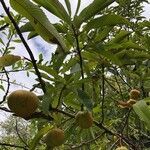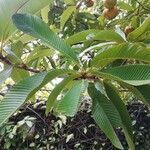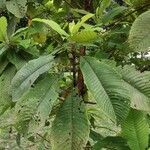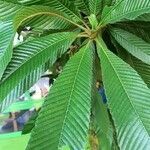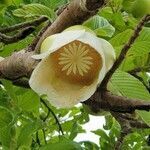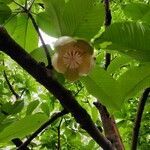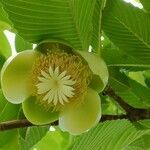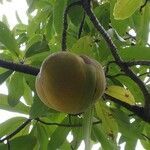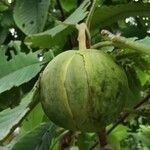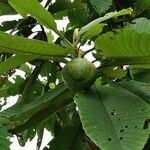Tree, up to 30 m high, 120 cm diam., with rather crooked trunk and irregular, usually rather lowly (up to 15 m) attached crown. Leaves bright green above, oblong, ca 25-50-nerved, 10-35 by 5-13 cm, on saplings and young trees up to 70 by 18 cm, with acute to acuminate apex, rounded to acute base, and slightly to manifestly dentate margin. Petiole 2½-7½ cm long, on saplings and young trees up to 15 cm. Flower 15-20 cm diam. Sepals 5, elliptic, 4-6 by 3-5 cm, up to 1 cm thick at the base. Petals white, 7-9 by 5-6½ cm. Stamens in 2 distinct groups, the outer ones, ca 550,13-15 mm long, straight in bud, the inner ones, ca 25, 20-22 mm long, with their apex reflexed in bud; yellow. Carpels 14-20, ca 14 by 3 mm, yellowish green, with linear-lanceolate, white, 25 mm long, up to 3½ mm broad styles; each with 40-80 ovules. Fruit indehiscent, yellowish green, 8-10 cm diam. including the enclosing sepals, which are up to 15 by 12 cm, 2½ cm thick at the base. Carpels ca 35 by 15 mm, each with 5 or more seeds in colourless glutinous pulp. Seeds reniform, 4 by 6 mm, black, finely echinate, exarillate.
More
An evergreen tree with a short trunk. It grows to 10-15-30 m high and spreads to 4-10 m across. The bark is rough. It has a dense round crown. The branches are straggling and droop at the end. The leaves are at the ends of branches. The leaves are deeply ribbed. They have teeth around the edge. The leaves are bright dark green. They are 15-25 cm long and 5-10 cm wide, but can be twice that size. The leaves have a bold pattern of sunken veins. The leaf stalk is 2-5 cm long. The flower buds are large and round and look like fruit. The flowers are large and white and 20 cm across. They are cup shaped. The flowers are produced in the upper leaf axils. The flower sepals thicken and cover the fruit to make a round green fruit up to 12 cm across. The seeds are kidney shaped with hairy edges. They are embedded in a glutinous pulp.
Evergreen trees to 30 m tall, ca. 1.2 m d.b.h. Bark reddish brown, exfoliating; young branchlets brown pubescent, glabrescent; leaf scars obvious. Petiole narrowly winged; leaf blade oblong or obovate-oblong, 15-40 × 7-14 cm, secondary veins (20-)30-40(-70) on either side, parallel, margin obviously serrate. Flowers solitary, 12-20 cm in diam., more than 5 cm in diam. in bud. Sepals 5, approximately rounded, 4-6 cm in diam., thickly fleshy. Petals white, obovate, 7-9 cm. Stamens in 2 distinct groups, outer very numerous, slightly curved in bud, inner ca. 25, apically reflexed outward in bud; anthers dehiscing with 2 pores. Carpels 16-20; stylodia spreading; ovules many per carpel. Aggregate fruit globose, 10-15 cm in diam., indehiscent; persistent sepals fleshy, slightly swollen. Seeds 5 or more per carpel, exarillate.
Fruit composed of fleshy sepals.
It is a tropical plant. It suits the tropical lowlands. It prefers rich moist soils. It needs a protected partly shaded position. It is drought and frost tender. They need a temperature above 15°C to grow. It grows in moist evergreen forest. In Papua New Guinea it is an introduced species and grows in coastal areas below about 600 m altitude. In Yunnan in China it grows between 600-1100 m altitude. In XTBG Yunnan. In the Cairns Botanical Gardens. It suits hardiness zones 10-12.
More
Mainly on stony banks of rivulets (Sa-raca-streams, CORNER) and rivers, mainly at low elevation up to 500 m. Once collected at 1700 m (Atjeh, Sumatra).
Evergreen forest or tropical rain forest, often along rivers. In Java especially in teak forest, up to 1,100 metres altitude.
The fruit can be used for jellies, curries and drinks. It is the fleshy sepals around the fruit that are eaten. They can be pickled. The fruit can be eaten raw. More commonly they are used in curries, especially prawn curries. They can be cooked with lentils. They can be made into jam. They are used for chutney. The sweetened fruit juice makes a cooling drink. The fleshy calyx can be stored for 20 days. The young leaves are eaten.
More
Uses. The fruit, in particular the enclosing sepals, is eaten fresh and in curries and jellies. With syrup a cough mixture is made from it. The wood, which is moderately hard and has a durability under water of ca 3 years, is sometimes used for house-building or gunstocks (India). The species is planted rather often as an ornamental tree.
